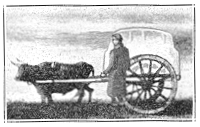
FORWARD
This booklet is dedicated to the memory of those
heroic Scotch Highlanders, who bravely faced loneliness and privations
that they might found a permanent home, a church, and school for their
children on these Iowa prairies.
It is true that to these noble
pioneers, and others coming from various places, that Scotch Grove owes
its character, its industry, and its courage.
The members of this
community today should be rededicated to the spirit of these pioneers
and continue to build along educational, moral, and religious lines.

ONE AFTERNOON in the late summer of 1837 a weary
little band of five Highland Scotch families pushed their tired oxen
south and west from the village of Dubuque, forded the Maquoketa river,
plodded on through groves of oak, elm and ash, over thickets of hazel
and alder until they reached the line where woods and prairie met.
This was their Land of Promise, a land without Laird or Factor,
toward which they had been traveling for nearly four months, a journey
of a thousand miles from the Red River of the North into this region, a
territory then known as the "Black Hawk Purchase." With thankful hearts
they made their first camp, unloaded their carts, and there established
the beginning of a home, and a community—Scotch Grove.
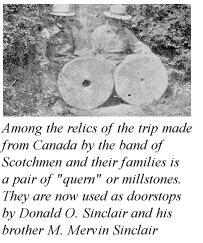 There
was no fanfare of trumpets, not even the skirling of the bagpipes,
perhaps only a simple Gaelic prayer of thanksgiving to mark the
beginning of this new era in the lives of these people. Yet this event
was history in the making; for this handful of Scotch men and women were
to share in the development of a great agricultural area. They were to
do their part for church and school, for government and country.
There
was no fanfare of trumpets, not even the skirling of the bagpipes,
perhaps only a simple Gaelic prayer of thanksgiving to mark the
beginning of this new era in the lives of these people. Yet this event
was history in the making; for this handful of Scotch men and women were
to share in the development of a great agricultural area. They were to
do their part for church and school, for government and country.
Here was no Plymouth Rock, and yet the same love of freedom and
independence animated these Highlanders as inspired those colonists of
Massachusetts Bay. They too had suffered much before they sought homes
in this brave New World, where they were to pass on to their children
their love of independent thinking and to imbue them with the spirit of
the pioneer.
The Eviction of the Highlanders
To the men
and women of this little band, heart-breaking journeys, dangers, and
privations were no new story. They had belonged to the group from
Sutherlandshire in Scotland known as the Selkirk Settlers, and for many
years had faced stark tragedy, dangers by sea and land, and had endured
terrible privations. They remembered the bitter days of the Eviction
when the large landholders of the north of Scotland diminished, or
cleared, the number of small crofts or holdings to make wide sheep runs
for rent to proprietors from the South, and so bring in more money to
the estates of these lords. This edict struck a terrible blow to the men
and women of Kildonan parish, driving them from their humble homes and
forcing many to seek refuge on the moors.
While these small
farmers or crofters lived humbly it was the only life they knew, and
they were content with a shieling of stone with a thatched roof, a few
black cattle and some sheep, a few acres of oats and a garden with
potatoes, peas, turnips and cabbage. These rugged moors had been their
home for countless generations, and they loved the heather-clad hills,
the white mist on Ben Laoghal, the brown streams dashing over mossy
rocks, the east wind blowing from the sea. Their ancestors, the wild and
unconquered Picts and Scots had dwelt here. These hills and mountain
passes had resound ed to their war cry and here many a plaided warrior
of these Highlands had laid down his life for kirk or clan.
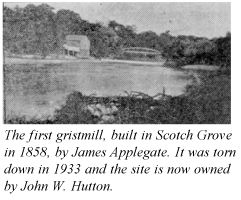
Deeply
religious, their church was doubly dear to them, since the men of
Kildonan for countless generations had worshipped on the same spot.
Kildonan, meaning the cell of Saint Donnan, had been established
there by Saint Donnan 617 A.D., and the church itself had been built
and rebuilt by the hands of Highland men. Situated on the banks of
the Helmsdale river (a corrupt form of the Gaelic for Ullidh's dale)
the kirk was the heart of the parish. Many of the shielings were
clustered about it, and these humble folk loved that churchyard
where their dead lay. Even today the worn and battered communion cup
they drank from, now kept in a place of honor in the parish, is an
eloquent testimony to their faith and devotion.
The bitter
words of the Eviction struck terror to the hearts of these people.
But they tried with all the means at their command to resist the
order of the cruel Duchess of Sutherland, a new heir to the estate,
who did not understand the Highland people. Her reply to the
deputation who visited her to try to convince her of the shame of
such an order is reported to have been: "You are an insolent lot for
all your meekness of mouth. I will have no more
dallyings with you. Tell your people to clear themselves, their
children, and their chattels from my holdings and at once."
]Nor was the Duchess the only landowner to drive out the tenantry,
for in Argyllshire, the Earl of Breadalbane had driven out the
entire clan of the McIntires from the land they had possessed from
time out of memory.
What was to become of these dispossessed
people was a problem not only to themselves but to the government.
In order to meet it in part, herring fisheries had been established
on the coast at Helmsdale, twelve miles from their village of
Kildonan and a part of the parish. But that life had no attraction
for men who loved the soil rather than the sea, and the sturdier
souls looked farther afield. To them came hope in the proposals made
by the agents of Thomas Douglas, Earl of Selkirk, to transport them
to a land in the New World called Assiniboia, located on the Red
River of the North.
Lord Selkirk's Colonization Plans
Lord Selkirk is often called a
remarkable man who lived before his time. He was an idealist, almost a
radical, with a passionate concern for the wrongs of the poor. Like most
idealists, he was not always practical nor did he show judgment in
choosing men to execute his plans. Therefore in carrying out his
projects especially in colonization schemes, there was an immense cost
in blasted lives and broken hearts, and he himself died a broken and
disappointed man.
He traveled widely for his day and had visited
Canada where he had become interested in the civilization of the Indians
and advocated the suppression of the liquor traffic with them. As early
as 1803 he established an emigration party of several hundred poor
people on Prince Edward Island.
Wrongs of Poor
Although a
Lowlander with a vast estate at the mouth of the Dee, he had spent much
time in the Highlands and had learned the Gaelic language. He attended
the University of Edinburgh, where he knew Sir Walter Scott and later
became a friend of Robert Burns with whom he thrilled over the wrongs of
the poor and loyalty to Scotland. The sufferings of the evicted
Highlanders touched his heart, and he began plans for a colony of these
people in the then wilderness called Assiniboia.
This land was
then known even to the Highland people through the activities of the
Hudson's Bay Company, which had controlled the rich fur trade of the
Dominion of Canada from Quebec to the Northwest Territory through a
charter secured in 1670 from King Charles II. Before 1680, there were at
least three forts and trading posts built in this territory, one of
these being York Factory on the west coast of Hudson Bay, later a place
of great significance to the colonists. The great rival of the Hudson's
Bay Company was the North West Company, which had defied the Royal
Charter and under the leadership of Alexander Mackenzie had become a
powerful foe.
Hudson's Bay Company
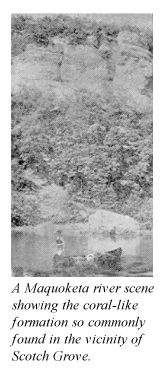 In 1808, Lord Selkirk having secured the control of the Hudson's Bay
Company had acquired from that organization approximately 110,000 square
miles of land, from the grand forks of the Red River and the Assiniboia
to the headwaters of Lake Winnipeg. This land was largely unbroken
prairie and included some of the best wheat land on the continent. While
the Earl undoubtedly launched his plan in the interests of the
impoverished and evicted Scottish farmers, he also had an eye to the
interests of the Company by providing cheap labor in the trading posts
and a ready supply of cheaper provisions in the country.
In 1808, Lord Selkirk having secured the control of the Hudson's Bay
Company had acquired from that organization approximately 110,000 square
miles of land, from the grand forks of the Red River and the Assiniboia
to the headwaters of Lake Winnipeg. This land was largely unbroken
prairie and included some of the best wheat land on the continent. While
the Earl undoubtedly launched his plan in the interests of the
impoverished and evicted Scottish farmers, he also had an eye to the
interests of the Company by providing cheap labor in the trading posts
and a ready supply of cheaper provisions in the country.
Now Lord
Selkirk was ready to promote his colonization plans actively. He sent
agents into the Highlands to describe Assiniboia as "A land with black
soil seven feet deep and no stones, with wood in abundance, fish and
game for the catching, and great stretches of grass as thick as heather
before the spring burning." Such homes were to be theirs free.
Applications from more than seven hundred of the evicted farmers came
in.
The North West Company, alarmed at the inroads a large
agricultural colony might make in the fur trade, countered with letters
to the "Inverness Journal" describing the atrocities of the Indians, and
the severity of the climate, all giving Assiniboia a very bad name
indeed. While these efforts dampened the enthusiasm of the Highlanders,
many still had faith in Lord Selkirk, and to the stronger and more
adventurous spirits his project had great appeal. Besides, these people
were in desperate straits and this new land offered a refuge and a hope
to them and their children.
Three Expeditions Are Sent Out
In 1811, Lord Selkirk had sent out a shipload of servants or
employees, about one hundred rough and rebellious men from Glasgow and
the Orkneys, to prepare the way for the settlers who were to follow.
Their boat left Stornaway in the Hebrides, July 26, 1811, and was
signaled at York Factory, September 24, sixty-one days after. This party
did not attempt to reach the Forks, the place of permanent settlement,
until the next summer, and then made the journey of 728 miles in
fifty-five days, arriving at what is now St. Boniface, across the river
from the present site of Winnipeg, in August, 1812. There they began to
clear the land for the settlers.
The second party, known as Owen
Keveney's party from the name of the leader, included seventy-one men,
women, and children and sailed on the "Edward and Ann" from Stromness in
the Orkneys.
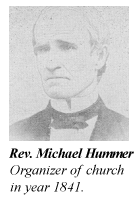 According to Dr. George Bryce, an authority on the history
of the period, the ships lists found in the archives at Ottawa and
Montreal are far from complete or correct. Of this group of seventy-one
only seventeen names are given, including that of a John McIntyre.
However, the Honor Roll in Martin's Hudson's Bay Company Tenures
indicates those who arrived each year, and this includes among the
arrivals of 1812 the names of Donald Livingston, Alexander Mclean, John
McLean, Alexander McBeath, and John Sutherland, all names significant in
Scotch Grove history.
According to Dr. George Bryce, an authority on the history
of the period, the ships lists found in the archives at Ottawa and
Montreal are far from complete or correct. Of this group of seventy-one
only seventeen names are given, including that of a John McIntyre.
However, the Honor Roll in Martin's Hudson's Bay Company Tenures
indicates those who arrived each year, and this includes among the
arrivals of 1812 the names of Donald Livingston, Alexander Mclean, John
McLean, Alexander McBeath, and John Sutherland, all names significant in
Scotch Grove history.
This party reached the Forks October 27,
1812, only two months after the first party, and found but little
preparation made for them, so they spent a terrible winter, suffering
from cold and scarcity of food.
In spite of discouragements at
home and abroad, in 1813 a still larger group of Kildonan families had
sold their few possessions and waited transportation. Lord Selkirk
himself came to Sutherlandshire in the spring of that year to make
arrangements, and his Gaelic speech and charming personality gave the
people new faith in his plan. Accordingly, the third party, known as the
Churchill Party, sailed on the "Prince of Wales," convoyed by H. M. S.
"Brazen," with the company's servants on the "Eddystone," from Stromness
in the Orkneys, June 28, 1813. Miles Macdonell was leader of the party
and Captain Turner had charge of the "Prince of Wales." Of the
ninety-seven names in the ship's list, the following information is
given concerning those from Kildonan who became associated with Scotch
Grove history in some way.
Sturdy Pioneers
"John
Sutherland, 60, died September 2, at Churchill, a very respectable man.
Catherine Grant 46, his wife; George 18, Donald 16, Alexander 9, his
sons; Janet 14, his daughter.
"Alexander Sutherland, 24; William
Sutherland, 19, his brother; Kate Sutherland 20, his sister. "Alexander
McKay 24; Jean 24, his wife. Robert Gunn, 20, piper; Mary Gunn, his
sister.
"John McIntyre to Port William, entered; service of
Hudson's Bay Company, July 1814."
The Voyage of the Churchill
Party
In his "History of Manitoba," Donald Gunn, born in
Caithness in 1797, who came with this party and who later became a
school master in the colony tells of the embarking vividly as it would
appeal to a sixteen year old boy.
"The people gathered at Thurso
(on the north coast) then by a boat, 'The Water Witch,' to Stromness in
the Orkneys. The embarkation commenced in the forenoon and by one
o'clock all were on board the craft. The forepart of the hold was formed
into a huge bin filled with oatmeal, the after part of the hold was
occupied by a bull and a cow of the largest and finest breed to be
obtained in Rosshire."
J. M. McCulloch in "The Men of Kildonan"
describes the scene with real emotion:
Leave Takings
"The
folks that were not of the expedition came down to the sea with us
carrying our dorlachs (baggage) and talking cheery. At last and long we
said our farewells for the last time and took our places on the crowded
boats. The shore fell away as the salt water lappered briskly against
our boats, and above our heads the white gulls whirled in confusion and
cried querulously, Duncan McDonald filled his bagpipes, and 'Cha till!
Cha till! Cha till! mi tuille' came from the chanter with the wail of
the Skye in it, and the booming of the angry seas. The wind wafted the
plaintive notes shoreward, and the old women on the pier spread their
plaids to the sky and cried 'Ochanerie' (exclamation of grief) across
the widening water. 'Cha till! Cha till! Cha till mi tuille' answered
the pipes. So we slipped away."
To a New World
 At Stromness the people were lodged in the homes of the inhabitants
until ready to embark. They had expected Lord Selkirk to meet them here
and to accompany them to Assiniboia but were disappointed to learn that
the affairs of the colony were such that the Earl would have to wait
until a later boat.
At Stromness the people were lodged in the homes of the inhabitants
until ready to embark. They had expected Lord Selkirk to meet them here
and to accompany them to Assiniboia but were disappointed to learn that
the affairs of the colony were such that the Earl would have to wait
until a later boat.
"The Prince of Wales" was a vessel of about
600 tons and sat low in the water. Her bows were iron-plated and the
water lines covered with oak to enable her to battle through the ice.
Shorty after the voyage began, an American privateer was sighted. The
convoy ship "The Brazen," chased and captured it and took it into an
English port?an incident of the War of 1812.
Crowded Quarters
The quarters of the emigrants near the bow of the ship were dark, cold,
and cramped. To provide privacy plaids were hung, and kilts were used
for pillows. When rough weather was encountered many fell ill from
seasickness. Then the dreaded ship fever, or typhus, broke out, and in
such close quarters it spread rapidly. McCulloch writes:
"In less
than a week the dreaded fever had swept the little ship. Hugh MacDonald
died painfully in the night. The wasted bodies of Catherine, daughter of
Donald Gunn of Borabal, and William Sutherland, a young man of great
promise, were consigned to the grey waters two days later. In the midst
of this horror the surgeon Laserre suddenly expired. The sick could not
be isolated, accommodations being limited. So the sick lay moaning among
the healthy in every part of the ship."
Fever Abated
After
three weeks the fever abated somewhat and those able to go on deck were
diverted and also alarmed by the huge icebergs encountered near
Greenland. On August first, vague outlines of the coast of North America
were sighted and Eskimos came to the vessel across the ice, laden with
furs and articles for barter. Heavy storms were met in Hudson Bay and
for three days the ship drifted drunkenly among the dangerous shoals,
but on August 29, the weary eyes of the people were gladdened by
glimpses of the land that meant hope to them.
Gruff Captain
What was the consternation of Miles Macdonell to find that Captain
Turner was landing them at Fort Churchill, a bleak outpost, instead of
taking them 150 miles south to York Factory where the colonists were
expected and where accommodations were ready for them. But the stubborn
Captain Turner would not be reasoned with, so the passengers were
literally dumped on the rocks of Sloop's Cove with their feeble and ill
amid the jungle of their gear.
And in that cold, inhospitable
spot, at least eight of the little party died during the month of
September; and the grave of John Sutherland plainly marked, remains
there to this day.
The Bitter Winter of 1813-'14
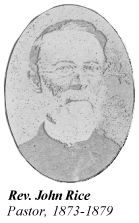 Since the colonists could not winter on the barren rocks of Sloop's Cove
nor elsewhere in that exposed area, it was decided to make a camp
fifteen miles from the fort on the wooded banks of the Churchill river.
In deep snow, with unfinished huts and scanty clothing the settlers
suffered terribly. Food was scarce and the nearest supplies were fifteen
miles away. The manual labor under such adverse circumstances was very
hard for them, but their leader said of them, "The settlers proved
willing though possessed of an indomitable Presbyterian aversion to work
on Sunday."
Since the colonists could not winter on the barren rocks of Sloop's Cove
nor elsewhere in that exposed area, it was decided to make a camp
fifteen miles from the fort on the wooded banks of the Churchill river.
In deep snow, with unfinished huts and scanty clothing the settlers
suffered terribly. Food was scarce and the nearest supplies were fifteen
miles away. The manual labor under such adverse circumstances was very
hard for them, but their leader said of them, "The settlers proved
willing though possessed of an indomitable Presbyterian aversion to work
on Sunday."
Scurvy attacked the camp, and too weak already the
settlers refused to submit to the bleeding, a general cure-all, ordered
by a surgeon of the company. Finally it was allayed by a medicine made
from spruce; and when myriads of partridges and herds of deer appeared,
the settlers recovered their strength and spirits on this diet of fresh
meat, and were eager to start for York Factory where they should have
wintered, a journey of 150 miles across the snow.
Forty-one left
in April, 1814, to attempt the march. Among these was the widowed
Catherine Grant Sutherland, her sons and her daughter Janet, "Little
Janet" they called her.
Overland Trail
When the little party,
equipped with snowshoes was ready to start, the four heaviest and most
active men took the ropes of the sleds at the head of the procession to
make a trail for the women and the children, and two active men brought
up the rear to check the stragglers. The bagpiper in the middle, at a
signal from Miles Macdonell threw the pipes across his shoulder and put
"The Road to the Isles" on the chanter.
They were soon afflicted
with snow blindness. They encountered blinding blizzards. The sharp
crust of the snowdrifts cut their knees so their trail was marked with
blood. But always there was their leaders to cheer them on, and at night
a cheery campfire with buffalo robes on the snow, plenty of oatmeal and
roasted partridges and gallons of hot tea.
When they reached York
Factory, plans were made to continue the journey to the Forks, a
distance of more than 500 miles. So this group with others, numbering
120 in all, left York, May 14, 1814, and traveling by boat and by
grueling portage, with 300 miles on Lake Winnipeg into the Red river,
and reached the Forks in fifty-five days.
There on the site of
the present city of Winnipeg Miles Macdonell in the name of Lord Selkirk
allotted to the head of each family, ten chains of land, or 660 feet, on
the banks of the Red river, the land running back to a distance of from
two to four miles. This method of allotment had the advantage of
bringing the houses of the settlers close together for protection and
communication, and also of giving each family a right to the river,
which furnished the only means of transportation and also provided them
with food and water. At the present time, some of these water lots are
held in Winnipeg, one in possession of the Robert McBeth family having
come down directly from Lord Selkirk.
The Fourth Party
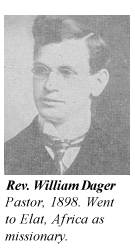 A
fourth party landed at York Factory, August 26, 1815, and proceeded to
the Forks, or Kildonan as it was affectionately called for the parish
that had been home to generations of these immigrants. This group was
especially important because it brought James Sutherland, an elder
called a Catechist and authorized to marry and baptize. Until his
removal to Eastern Canada he took the place of the Presbyterian minister
Lord Selkirk had promised these people—a promise he did not fulfil.
Others listed in this party are William Sutherland, 54; Isabel
Sutherland 50, his wife; Jeremiah 15, Ebenezer 11, Donald 7, Helen 12,
his children. The last three are mentioned as being at school. The three
eldest children of this family, Alexander, William and Kate or Catherine
had come with the third party, William dying at sea.
A
fourth party landed at York Factory, August 26, 1815, and proceeded to
the Forks, or Kildonan as it was affectionately called for the parish
that had been home to generations of these immigrants. This group was
especially important because it brought James Sutherland, an elder
called a Catechist and authorized to marry and baptize. Until his
removal to Eastern Canada he took the place of the Presbyterian minister
Lord Selkirk had promised these people—a promise he did not fulfil.
Others listed in this party are William Sutherland, 54; Isabel
Sutherland 50, his wife; Jeremiah 15, Ebenezer 11, Donald 7, Helen 12,
his children. The last three are mentioned as being at school. The three
eldest children of this family, Alexander, William and Kate or Catherine
had come with the third party, William dying at sea.
In this
fourth group was the family of Alexander McBeath, listed as an old
soldier, a member of the 73rd Highlanders, and said to be one of the
survivors of the Black Hole of Calcutta. His children were Margaret 18,
Molly 18, (evidently twin sisters) George 16, Roderick 12, Robert 10,
Adam 6, Morrison 4.
Those of the Sutherland family connected with
Scotch Grove history were the mother Isabel, who died shortly after her
arrival here; Alexander, Ebenezer, Donald, and Kate who came as the wife
of John McIntire. Of the McBeath family, Margaret came to Scotch Grove
as the wife of John Sutherland. One of the McBeath sons married a
daughter of Donald Livingston, and their daughter Johanna was the wife
of John E. Lovejoy; while Annie, another daughter, married John O.
Callahan, both families closely connected with this community.
Trouble With the North West Company
The colony was growing
gradually and with their own land, houses and barns, with supplies and
tools furnished by Lord Selkirk, and with families and clansman reunited
the prospects appeared rosy for the settlers. But the agents of the
North West Company were again actively working against Lord Selkirk and
the Hudson's Bay Company, thus making life very hard for the colonist.
The first move to reduce the growing Kildonan colony was made when the
North West Company offered two hundred acres of land in Eastern Ontario
to every settler who would leave the West. Many agreed and left, but
Catherine Sutherland, said, "As for me and mine we will keep the faith.
We have eaten Selkirk's bread, we dwell on his lands. We stay here as
long as he wishes and if we perish we perish."*
* Note: "Whoever
may have said this, as well as another quote later attributed to her in
(this) article, it wasn't Catherine Sutherland. She and her children
(including 'little Janet' who is referred to a bit later in the
article), did in fact go to Eastern Ontario in 1815 in the North West
Company canoes." (Chloe Clark)
In June, 1815, the settlers
remaining received a notice from Cuthbert Grant, the North West warden,
which said, "All settlers to retire immediately from the Red River and
no trace of a settlement to remain." An attack by North West men and
half-breeds, the Bois Brules in their employ, was made on the colony and
Governor Macdonnell was taken prisoner, so the settlers left their homes
and went in canoes to Jack River while the Bois Erules set fire to their
homes and barns and trampled the growing crops.
This had happened
before the arrival of the fourth party in the fall of 1815, and then
encouraged by the new brigade the settlers returned to Winnipeg. Lord
Selkirk, who was at Montreal, knew nothing of this attack as the North
West people intercepted the letters until finally. Baptiste, a French.
Canadian, took a message to him.
But in the summer of 1816, Grant
again led an attack of Bois Brules against the colony. Tradition has it
that "Little Janet" Sutherland warned the settlers and thus saved many
lives before the massacre of Seven Oaks, which resulted in the death of
Governor Semple and a score of men. Again the settlers were driven out,
and they wandered around Lake Winnipeg without shelter or food except
berries and the fish they caught. Sometimes the Indians gave them meat,
and Grant himself brought them some food in a boat.
It is
recorded that when he came to the Widow Catherine Sutherland where she
sat with Janet and Sandy, her youngest, the Highland woman stood up and
laughed scornfully at him; "I cannot curse you, Cuthbert Grant, for I am
a Christian woman, and if you came to me hungry I would feed you, for so
Christ bade us do to our enemies. But he never commanded that we should
take food from our enemies—so I throw your charity in your face."
Finally, Lord Selkirk himself came to the rescue of his unhappy
people. With a force of hired soldiers he punished the North West
Company for their acts and brought peace to the colony. According to Dr.
George Bryce's, "The Scotsman in Canada," when the Earl visited the
settlement in 1817, he shook the hand of every one, listened to their
complaints, and before his departure gathered them on the spot where the
church and burial grounds of St. John's Cathedral stands today. "The
parish," he said "shall be Kildonan. Here you will build your church and
that lot," pointing to the prairie across the little stream "is for a
school."
The Earl returned to England in 1818, and in 1820 he
died in the South of France a disappointed, heartbroken man. A year
later a union was brought about between these two rival companies under
the name of the Hudson's Bay Company.
Growth of the Colony
 Alexander
Ross, a one time sheriff of Red River and a member of the first council,
in his book, "The Red River Settlement." published in London in 1856,
relates the successes and trials of the growing colony.
Alexander
Ross, a one time sheriff of Red River and a member of the first council,
in his book, "The Red River Settlement." published in London in 1856,
relates the successes and trials of the growing colony.
He
writes: "In 1817 the industry of the settlers was amply rewarded by the
results at harvest time; forty-fold was a common return and in one case
for a bushel of barley some fifty-six were reaped; and for a bushel of
seed potatoes one hundred and forty-five bushels. These facts were
related to the writer by John McIntire, an intelligent settler."
The Rev. James West, an Anglican missionary, says, "Indian corn, every
kind of garden vegetables, watermelons and pumpkins grow and mature.
Tobacco plants fail as do flax, hemp, and winter wheat. Wild raspberries
and strawberries are abundant."
But just when everything appeared
so favorable, hordes of grasshoppers came in 1818 and again in 1819 and
ate all the growing crops, so the settlers had to spend the winter on
the Permbina river, where the buffalo ranged, and lived almost like
savages.
Since there was no seed wheat that year several men were
sent to Prairie du Chien, described as a town on the Mississippi several
hundred miles distant. These men reached their destination on snowshoes
at the end of three months and purchased two hundred and fifty bushels
of wheat at ten shillings ($2.50) per bushel They made their way back in
flat-bottomed boats, arriving June 20, late for sowing the wheat, but
still enough matured to furnish seed for the following year. This
expedition cost Lord Selkirk 1,040 pounds; and it revealed to the
settlers the possibilities of the land to the south of them.
The
Journal of Robert Campbell, one of the settlers, tells the story of an
unsuccessful attempt to bring sheep from Kentucky in 1838, and speaks of
reaching Prairie du Chien and Galena, Illinois. He also writes of the
speed and endurance of "Fireaway," the splendid bay stallion imported
from England. Three hundred head of cattle were brought from America,
and the cows sold for 30 pounds ($160) and oxen for 18 pounds ($90).
Later importations were bought by the colonists for much less money.
Along with the "ups" were many "downs" for the colonists. One of
these was the terrible flood in the spring of 1826 when the water stood
ten feet deep on the land that had once been farms. Houses were carried
into Lake Winnipeg and the settlers fled for their lives, only to return
and to start rebuilding when the water subsided.
Various
commercial schemes were tried, some bringing in good wages for the
settlers. One of these was the Buffalo Wool Company, an attempt to make
cloth out of the wool of the buffalo. This sent wages up to fifteen
shillings a day ($3.75) while it lasted. The Assinibolia Wool Company
was another foolish project that soon blew up, as did a Tallow Company.
The farmers' wives began to spin for small wages, but still bringing in
some income.
The general prosperity of the colony may be judged
by the fact that in 1880 two hundred new houses had been built. A
reproduction of the living room of one of these homes is now a part of
the museum in Winnipeg, all of the furniture being original articles.
This shows the fireplace filling a space in the main wall with its
chimney jack, tongs, iron pot, iron kettle, and handled frying pan. The
flintlock rifle and powder horn occupy prominent places over it. At one
side of the room are the querms, or stones used for grinding flour,
while the mortar and pestle for crushing oatmeal is at the other. The
earthen floor is covered with woven reed mats, the chairs are hand made,
the wood fastened together with elk hide; the spinning wheel is
seemingly the finest piece of furniture; the dishes are of pewter or
buffalo horn. A besom (broom), a chopping bowl, candle-molds, molasses
jug, and a tinder box about complete the furnish- ings. The leather
covered Bible occupies a prominent place however.
Dr. Speechly,
head of the Winnipeg Museum, has collected numerous single articles that
fill a large case. Among these are an ox's shoe, a water yoke, wooden
hay forks and rakes, several sickles, hand made bits and drills, a
buffalo skinning knife made from an old sword, a cribbage board, a
curling stone, a flail, a hand seeder, traps, and a Red River cart. The
most perfect specimen of these carts is in the Hudson's Bay Company
Museum also at Winnipeg.
Weddings Play a Part
 That life in Red River was not all struggle and hardship, mixed with
Gaelic prayers, as the descendants of these pioneers were sometimes led
to think, is evident from the letter written by Thomas Simpson at Fort
Garry to Donald Ross at Norway House in 1834.
That life in Red River was not all struggle and hardship, mixed with
Gaelic prayers, as the descendants of these pioneers were sometimes led
to think, is evident from the letter written by Thomas Simpson at Fort
Garry to Donald Ross at Norway House in 1834.
"I will now give
you a spice of Red River gossip. All the 'nobility' attended the wedding
of Nancy Livingston and Donald Sutherland. We bachelors danced our legs
off almost, smacking the lasses ad infinitum. Tell Mrs. Ross that her
niece, John's daughter is now the prettiest girl in Red River. John
Livingston may marry Sophy McDonnell, Allan's daughter. Dr. Bunn is
beginning to vaccinate since hearing of your success at Norway House."
Other Red River marriages important in Scotch Grove history were
those of Ebenezer Sutherland and Sarah Gunn, John Sutherland and
Margaret McBeth, Catherine Sutherland and John McIntire. The wife of
Alexander Sutherland was always referred to as "Aunt Jean," her maiden
name not being stated.
Fort Garry was the newest and most
important post, while Norway House on Lake Winnipeg and York Factory on
Hudson Bay were also large trading centers. A William Sinclair was chief
factor at York, and James Sinclair at Fort Garry, where his daughters
Margaret and Harriet were called the belles of the Fort. Mary Sinclair
danced with Sir John Franklin at Norway House on his return from an
Arctic expedition.
Schools have always had a prominent place in
the lives of Scottish people and the Red River settlement was no
exception. What they studied, the books they read, if any besides the
Bible and Westminister Catechism, were not discussed by the pioneers,
but the punishments at school were often enlarged upon. But however
harsh and limited the schools, the young people had some opportunity for
an education.
John Matheson, who came from. Kildonan in 1815, was
listed as a schoolmaster; also Donald Gunn was a teacher. The Rev. David
Jones came to the colony in 1828 to preach in the Anglican church and to
teach. Mrs. Jones, wife of the missionary joined her husband. in 1829
and opened a school for young people, which continued until her death in
1836. Mrs. Jones was often quoted as an authority by the pioneer women
in Scotch Grove. John McCollum, a student from Edinburgh came in 1883 to
assist Mr. Jones in St. John's school.
Teachers and governesses
who came from England married so quickly it was hardly worth while to
bring them out. The story goes that a committee appointed to select some
mature women approached a widow aged eighty-five, but even she would not
promise to remain single on the chance of an especially advantageous
marriage in Canada.
Most of these schools were for the children
of the Hudson's Bay Company employees, and Alexander Ross in his
"History of Manitoba" records that the schools were not satisfactory to
the Scotch settlers.
Religious Matters Irk Colonists
Their
worship was one of the sorest spots in the settlement for the
Presbyterian adherents. Lord Selkirk had promised them their own
minister, who would be to them what the Rev. Alexander Sage had been in
Kildonan. At the time of the Eviction, Rev. Sage had felt he was to old
to accompany them, but he did all in his power to ease their burdens and
to encourage their going to the new land. He is buried in the Kildonan
churchyard with his "deceased spouses" Mistresses Isabel Fraser and Jean
Sutherland, as the inscription reads. The pulpit from which he preached
to these Highland men and women still stands in the church.
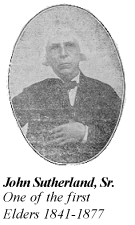 The
immediate spiritual needs of these Presbyterians was supplied by James
Sutherland the catechist, until his removal to Eastern Canada. All the
requests for a minister of their own were ignored by Lord Selkirk and
later by his agents, and not until 1852 did the Red River Settlement
have a Presbyterian minister. Then the Rev. John Black came, and the
Kildonan church was built along the same lines of architecture as the
mother church in Sutherlandshire. The Scotch Grove church building also
shows the influence of this mother church.
The
immediate spiritual needs of these Presbyterians was supplied by James
Sutherland the catechist, until his removal to Eastern Canada. All the
requests for a minister of their own were ignored by Lord Selkirk and
later by his agents, and not until 1852 did the Red River Settlement
have a Presbyterian minister. Then the Rev. John Black came, and the
Kildonan church was built along the same lines of architecture as the
mother church in Sutherlandshire. The Scotch Grove church building also
shows the influence of this mother church.
While the
Presbyterians did not have their own minister they found the Anglican
clergyman the Rev. Jones, kind and indulgent. He laid aside certain
parts of the liturgy and let them stand to pray and sit to sing. They
accounted him a fine and eloquent preacher tender-hearted, kind and
liberal to a fault. But about 1835, the Rev. Cochran was sent out and
was much dissatisfied with the liberal policy of the Rev. Jones toward
the Presbyterians, and he handled them more roughly.
He said; "I
will preach to them the truth of the Gospel and they must listen to me.
They have nothing to do with our forms. I will not allow them an inch of
their own will."
Besides the troublesome religious situation,
neither economic nor political conditions were satisfactory to many of
the Selkirk settlers. In 1835 the Hudson's Bay Company attempted a
legislative council, for the colony now numbered 5,000 inhabitants. The
personnel of this group was not especially popular, nor was the general
plan since it linked church and state. The high duty on imports from the
United States was irksome and the prices charged by the company often
were 75 per cent above London prices. With the uncertainty of crops, the
failure of commercial enterprises, and general dissatisfaction with the
government it is not surprising that many looked for new fields.
The Swiss colony of 248 had emigrated to the United States from Red
River about 1830. Alexander Ross writes in 1886, "A group of 148
persons, chiefly of the Presbyterian party, left the settlement for the
United States carrying along with them much valuable property." It would
be interesting to know where this group settled. A number had gone into
Eastern Canada, among these Catherine Sutherland and the younger members
of her family. This intrepid pioneer lived to pass the nonagenarian mark
in the home of her son, Donald. Her granddaughter, Mrs. Mary Braden, had
vivid recollections of filling all the water buckets on Saturday night
since the grandmother, hence the family, would not drink water pumped on
the Sabbath.
Glowing reports of the conditions in the United
States reached the settlers frequently, so Alexander McLean later
spelled McClain went down to the recently opened strip of territory in
Eastern Iowa known as the Blackhawk Purchase and brought back a fine
report of the conditions of the land about thirty miles south and west
of Dubuque.
The Emigration to the United States
It will be
remembered that John Sutherland as a young man was among the first of
the Kildonan group to come to the Red River, being a member of the
second party, so now in 1837 as a middle-aged man he was one of the
early movers in the enterprise of moving to the United States. With his
wife Margaret McBeth, who had come with the Churchill party at the age
of eighteen, he had his children—John, Alexander, George, David, Donald,
Roderick, William, Catherine, Adam, and an infant daughter, Christina.
Alexander Sutherland, who had come with the Churchill party at the
age of twenty-four, had preceded his father and mother, William and
Isabella Sutherland and the younger members of his family. Now with his
wife "Aunt Jean"—and those of their children William, Elspeth "Eapie",
and John—who were born in Red River, he too was ready to try another new
country.
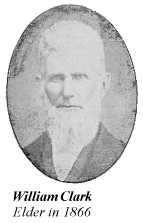 Other
families in the party were whose of Alexander McLean, David McCoy,
(originally spelled McKay). These people seem to have settled farther
west and north than the others. The McCoy spring has always been one of
the landmarks of the township. The fifth member of the party was Joseph
Bremmer. He evidently was a widower, for he and his son called "Willie",
a cripple, lived alone many years. The McCoys and the Bremmers are not
named in the ship's list of the first parties, so they had evidently
joined the Selkirk settlers at a later date, as did the Donald Sinclairs
and other families who later came to Scotch Grove.
Other
families in the party were whose of Alexander McLean, David McCoy,
(originally spelled McKay). These people seem to have settled farther
west and north than the others. The McCoy spring has always been one of
the landmarks of the township. The fifth member of the party was Joseph
Bremmer. He evidently was a widower, for he and his son called "Willie",
a cripple, lived alone many years. The McCoys and the Bremmers are not
named in the ship's list of the first parties, so they had evidently
joined the Selkirk settlers at a later date, as did the Donald Sinclairs
and other families who later came to Scotch Grove.
The Red River
or Pembina cart was the vehicle used for this thousand mile journey.
This was a product of the locality, doubtless of French origin, and
handed down to the Bois Brules or
half-breeds, by their French ancestors. For seventy-five years it was
the freight car and family carriage of the community. The only tools
needed to make the cart were an axe to cut down a tree and a gun to
"shoot an elk or buffalo. Two huge wooden wheels over five feet in
diameter with eleven or twelve spokes set into a wooden hub seemed the
most essential feature. The body was made of rough boards laid
lengthwise and pegged down by one crosswise board pegged to the axle. A
rude framework several feet high to be covered by a buffalo skin
completed the body. The shafts were an extension of a board in the body
with a hole bored about a foot from the end, to which the harness
holding the ox drawing the cart was attached.
This was the Red
River cart which carried these Scotch Grove pioneers and their
belongings in a thousand mile journey over nightmarish roads or no roads
at all In sloughs or deep mudholes the long spokes enabled the wheels to
reach solid ground. 'When they had to cross deep streams, they lashed
the wheels together to form a raft for the body, the men and animals
swimming the current. There were no luxurious springs to tempt even the
most tired travelers with promises of easy riding, and its approach was
heralded for miles by the screech of the wooden axles.
With these
carts loaded with from seven hundred to a thousand pounds and followed
by whatever livestock they owned, these pioneers traveled southward
through that summer of 1837. Burning sun, violent hailstorms, wind and
rain beat upon them in turn as they plodded on; mosquitoes and flies
tormented them; fear of wandering Indians harassed them. At night the
carts became their fortress as hub to hub they were placed in a circle,
while within this rude stockade the travelers cooked, ate, and slept,
always guarded by one of their number. The story goes that their hired
guide became insane, or at least very unreliable and caused them many
anxious days and nights.
They came down the west side of the
Mississippi River to Dubuque and then pushed on across the Maquoketa
River to the edge of the native timber. Here after four months of travel
they felt they had found an abiding place.
But tragedy marked
their arrival rival, for Christina, the baby daughter of John and
Margaret Sutherland worn out by the long journey died. The same night,
frightened by a prairie fire the family fled, the mother carrying the
dead baby in her
arms. The next day they buried her in the land they
had chosen for their home, and there she still lies, the first white
person buried in Scotch Grove township.
Other families came from Red
River the next year, 1838. Among these were Donald and Ebenezer
Sutherland, their young families, and their mother Isabella, who died
the following year; Donald Sinclair, his wife and their children
Christina, Elizabeth, and Angus. Mrs. Sinclair had been a waiting maid
in a noble family and her stories of court life were in great demand by
her companions. John McClain and his family were members of this party.
In 1840 came Donald Livingston, David Esson, and John Livingston,
making about seventy-five persons in all. On the way Grandmother
Livingston broke a leg in climbing down from one of the carts. The men
set the broken bone, and when the Mississippi was reached they made a
raft on which they placed her with one of her sons to pole down the
stream. Eventually, she joined the caravan and they all found their way
into Scotch Grove. Another Scotch settlement was formed called the Upper
Grove, later Hopkinson by the families of James Livingston, Alexander
Ross, Angus Matheson and others.
The Meaning of This Centennial
In
this year of 1937 it is these pathfinders of 1837, '38, '39, and '40
that their descendants and the people of a community would honor. While
poor in gear they brought here a wealth of memories and experiences.
These people had known the glory of the heather on the Scottish moors;
they remembered the cruel words of the edict from Dunrobin castle; their
hearts had thrilled to Gaelic words in Kildonan kirk; they had braved
the terrors of the Atlantic and endured privations in the Northland.
But through all the changes life had brought these Highland men and
women they carried in their hearts and brought to their new home those
virtues that had sustained them—faith, courage, independence, loyalty.
These are the qualities that made them great. This was their heritage to
this community.

THE LONG JOURNEY having ended and with thankfulness in their hearts
for their safe arrival, the sturdy Scotch pioneers began to build their
homes. No survey having been made of the territory, each settled where
he chose, built log cabins in the clearings, and carried on most of the
work of spinning, cooking, weaving, and washing outdoors in the manner
of their former homes. Donald O. Sinclair, his brother M. Mervin, and
Frank D. Sutherland, grandsons of these pioneers, are the only direct
descendants of these first Scotch, living here in Scotch Grove now.
Indians
Indians roamed the territory and tradition states that at
the close of the Black Hawk War in 1883, Lieutenant Jefferson Davis and
Abraham Lincoln, commanding a band of soldiers, pursued a number of
Indians to Dale's ford. The river was high and swift and while part of
the Indians stood guard, the rest swam to safety on the other side and
they in turn guarded while the remaining ones crossed the river. Such
strategy won the approval of the white men and the pursuit was
abandoned. As late as 1873 begging and thieving Indians were common and
were often annoying to the early settlers.
Churches and Schools
One of the characteristics evidenced in these pioneers was their
religion and soon after settlement the first church of Edinburg was
organized in 1841, the first building being erected in 1851 and the
second which is still in use being built in 1861. A Methodist church in
1853, a Christian or Campbellite church in 1872, a Presbyterian church
in Wayne township in 1861 and three German churches organized in 1856,
1874 and 1876, evidenced the religious character of the early settler.
Branches of the Presbyterian church were formed in Monticello, Center
Junction, Bethel, and Onslow. In 1850 the schools in the locality were
founded while prior to this time educational facilities were very
irregular. However from this time on, schools were rapidly located and
in general were overcrowded.
Newcomers and Their Influence
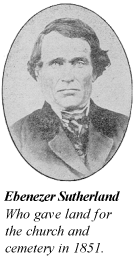 From
1845 on German, Irish, and Yankee settlers came to the locality and much
of the progress of the settlement is due these people as well as those
who came before them. After settlement for the first few years the only
mill where corn and wheat could be ground was on Catfish Creek, near
Dubuque. In 1847 a sawmill was built at Dale's ford, but it was entirely
washed away in 1865 and never rebuilt. In 1858 Charles Applegate* built
a gristmill and later a sawmill, which has since been operated by Samuel
Eby, his son Joseph, and William Lange. The mill itself has been torn
down and the property belongs now to John W. Hutton. In 1860, J. P.
Tibbits had a small sawmill five miles above Dale's ford, but this was
washed away in 1876. All that remains at the place is Mr. Tibbit's grave
on a nearby, high bluff. One other small mill was operated on Mineral
creek but only a short time.
From
1845 on German, Irish, and Yankee settlers came to the locality and much
of the progress of the settlement is due these people as well as those
who came before them. After settlement for the first few years the only
mill where corn and wheat could be ground was on Catfish Creek, near
Dubuque. In 1847 a sawmill was built at Dale's ford, but it was entirely
washed away in 1865 and never rebuilt. In 1858 Charles Applegate* built
a gristmill and later a sawmill, which has since been operated by Samuel
Eby, his son Joseph, and William Lange. The mill itself has been torn
down and the property belongs now to John W. Hutton. In 1860, J. P.
Tibbits had a small sawmill five miles above Dale's ford, but this was
washed away in 1876. All that remains at the place is Mr. Tibbit's grave
on a nearby, high bluff. One other small mill was operated on Mineral
creek but only a short time.
*Note: The mill was begun by two
brothers, James Stinson and Charles Reno Applegate. My family records
give the following account of their family's journey from Ohio to Iowa:
"Arrived at Dubuke, Iowa 1 Jan 1857.
Crossed Mississippi on foot, on ice. Stayed in Jackson county, Iowa for
the rest of that winter. Moved to Jones county, Iowa in late spring of
1857, started building the grist mill. Ran out of money and moved back
to Jackson county late that fall. Finished the mill in 1858, then began
building his house." Courtesy Stan Barnhill and the Applegate family
records.
War History
Scotch Grove was far ahead in its quota of men for the
Civil War and in memory of those men and those in the wars of 1812 and
the Spanish war, there is a monument in the Scotch Grove cemetery. In
the World War Scotch Grove was again well represented and there were
fortunately few casualties among the men who went.
Scotch Grove
Village
First known as "Applegate's Crossing" the laying of the
railroad and the platting of the village brought about the change in
name to Scotch Grove, in honor of the first settlers. The first
postmaster was commissioned in 1861, a store, elevator, creamery,
blacksmith shop, and an evergreen nursery were all prospering before
1876. Never incorporated, the village has grown into a neat, prosperous
small group of business ventures.
Progress and Prosperity
In
spite of hardships the people in the locality are noted as honest,
home-loving and prosperous. They are patriotic, religious, law-abiding
and by careful planning of their affairs they use methods in their work
that have proven to be of worth, discarding those impractical ways and
with an open mind to new ideas for better ways to bring better results,
they have been rewarded in progress and prosperity.
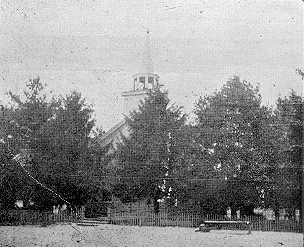

THE SCOTCH GROVE Presbyterian church was
organized in the Donald Sutherland home in June 1841, by the Rev.
Michael Hummer, with twelve charter members as follows:
John Sutherland.
Margaret
(McBeth) Sutherland—his wife.
Donald Livingston.
Ann
Livingston—his wife.
Donald Sinclair.
Ann
(Gibbs) Sinclair—his wife.
James Livingston.
Sarah
Livingston—his wife.
David
Esson.
Margaret Esson—his
wife.
Alexander McClain.
Sarah Sutherland.
At first the church was called "The First
Church of Edinburg," it being the expectation that Edinburg would be the
county seat of this county. Because the members were few in number,
services were held in the homes, very often in the Donald Sutherland
home, although others took their turn too. Rev. S. Cowles, of West
Point, visited this organization five or six times a year until in 1849,
when Rev. F. A. Pratt served for a few months and his wife taught a
select school in a room in the Ebenezer Sutherland home. After the town
of Edinburg failed to grow, Ebenezer Sutherland offered to the church
seven acres of land on the northeast corner of his farm "for church
purposes and a cemetery." This offer was accepted as more of the
membership was on this side of the prairie.
 From
Mrs. Lottie Sweesy Johnston, a granddaughter of the giver of the
land we learn "that during the short time for which Rev. James
Galitan was their minister, the membership built the first house
of worship in the summer of 1851. This church, a small frame
building, was erected in the cemetery a short distance northeast
of where the soldiers' monument now stands. N. W. Austin and his
helpers, Mr. Stewart and Mr. McFadden, were given the building
contract. The stone was furnished by Ebenezer Sutherland from
the quarry on his farm. Most of the frame timber was obtained
from the Rev. F. Amos' saw mill above Dale Mill bridge on the
Maquoketa River. Since the mill could not supply oak timbers
sufficiently long for the cross beams to support the ceiling,
these were taken from the timber. Ebenezer Sutherland, his son
D. W. Sutherland and William A. Sutherland went out into the
woods and wherever they found a tall, straight oak tree they cut
it no matter on whose land it was. When they raised the frame,
all the neighborhood gathered to help, and were served a picnic
dinner by the women.
From
Mrs. Lottie Sweesy Johnston, a granddaughter of the giver of the
land we learn "that during the short time for which Rev. James
Galitan was their minister, the membership built the first house
of worship in the summer of 1851. This church, a small frame
building, was erected in the cemetery a short distance northeast
of where the soldiers' monument now stands. N. W. Austin and his
helpers, Mr. Stewart and Mr. McFadden, were given the building
contract. The stone was furnished by Ebenezer Sutherland from
the quarry on his farm. Most of the frame timber was obtained
from the Rev. F. Amos' saw mill above Dale Mill bridge on the
Maquoketa River. Since the mill could not supply oak timbers
sufficiently long for the cross beams to support the ceiling,
these were taken from the timber. Ebenezer Sutherland, his son
D. W. Sutherland and William A. Sutherland went out into the
woods and wherever they found a tall, straight oak tree they cut
it no matter on whose land it was. When they raised the frame,
all the neighborhood gathered to help, and were served a picnic
dinner by the women.
The windows, hardware and some
lumber had to be obtained from Dubuque. Elder Donald Livingstone
and Ebenezer Sutherland advanced the two hundred dollars
necessary to pay for these. Interest rates of twenty to thirty
per cent were usual in these times. The interest, as well as the
principal, was never repaid, but the debt was canceled. The
congregation soon outgrew the little frame church and in 1861 a
second church, the present one, was built at a total cost of two
thousand dollars, which was financed entirely by the Scotch
Grove congregation. There was much discussion over the site of
the second building, one suggestion being a place four miles
west of the present site. Another was "on the high ground on the
Lovejoy farm half a mile west of the present location." Mrs.
Johnston closes this section of the church history with the wish
"that God will make this church the Way of Righteousness to Men"
and this wish seems to have become true in these following
years.
The Manse
The manse or parsonage, as it was then called, was built
in 1898 and was financed entirely within the congregation. From 1893 to
1921 this house was the minister's home until the time came when this
congregation and that of Center Junction were served by the same
minister who, since then, has lived in Center Junction
The
Church Bell
 Robert
Sutherland Rummell a great, great grandson of one of these pioneer men,
tells us as follows about the church bell:
Robert
Sutherland Rummell a great, great grandson of one of these pioneer men,
tells us as follows about the church bell:
It was in 1878 that
Dr. Alex McKean of Scotch Grove was appointed a committee of one to
raise funds for a church bell. Dr. McKean found his task no easy one for
the thrifty Pennamites of the community objected to the expense
entailed. However after two years of conscientious effort, two-hundred
and fifty dollars were raised for the purchasing of a Meneley bronze
bell of seven-hundred pounds weight.
Mr. Austin, who built the
church in 1861, raised the bell to the steeple in 1880 with the use of a
team of horses and block and tackle. After the bell was in the tower it
was sounded for five minutes continuously and then at intermittent
periods throughout the day to tell the church people that Dr. McKean's
task was completed.
The old bell was rung at the time of anyone's
death—first, to denote the joy at their birth and second, to tell the
community the age of the deceased. The bell would sound out in sorrow
the day of that person's funeral from the time the procession left the
house to the time it reached the church and it was in 1902, at the death
of Mrs. Angus Sinclair, that the bell was last tolled.
Sunday
morning brought life to the church for the sexton would call the Scotch
together to worship with the bell.
C. A. Sutherland said that one
time the bell became loose in its fastenings and if the sexton had not
visited the belfry, acting on a idea that something was the matter, the
bell would have dropped to the church lobby, to crush whosoever might
have been ringing it.
Enclosed by timbers end the dust of years
the old bell has within its fruitful span of life, witnessed the
establishment and prospering of a God-loving group of humans and at any
time it may be called upon to again bring a group to worship at the
church on the prairie.
Music in the Church
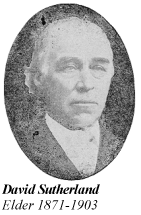 Music in the church was always a part of the service, and more people
sang then than do now. Hymn books were very few and the hymns were
"lined out" so that all might use the words. The tune was "pitched" by
someone who used a tuning fork, a small metal fork about the length of a
lead pencil, which when struck on a hard surface, produced an "A" tone
from which the leader took his pitch.
Music in the church was always a part of the service, and more people
sang then than do now. Hymn books were very few and the hymns were
"lined out" so that all might use the words. The tune was "pitched" by
someone who used a tuning fork, a small metal fork about the length of a
lead pencil, which when struck on a hard surface, produced an "A" tone
from which the leader took his pitch.
The organ was a different
matter. Some were anxious to use it and others opposed its use. However,
after awhile an organ was secured for use in the Sabbath school. It was
several months after it was used before some of those opposed came back
to church but, growing gradually accustomed to it and seeing no bad
effect because of its use, there was no further opposition. In 1917 or
1918 a piano was purchased, but the organ still stays in the church too.
Solos and quartets were unknown in the early church music, almost
everyone singing the melody. Gradually part singing came into use, then
a choir and special music and perhaps less congregational singing.
Music is, and should be, a part of worship in which everyone may
join.
Branch Churches
The first break in the membership of the
Scotch Grove church was in 1861 when twenty-eight members were "set off"
to form the Wayne Presbyterian church.
On June 14, 1870, the
Bethel church was organized with 18 charter members "mostly from the
Scotch Grove Church."
In November, 1871, the Onslow church was
organized with twelve charter members who again were "mostly from the
Scotch Grove church."
In 1852, on April 27, the Monticello
Presbyterian church was organized with fourteen charter members some of
whom had formerly belonged to the Scotch Grove church.
All these
breaks in the membership weakened the original church, particularly the
first one in 1861 when the building of the new church was going on, but
those who remained after each new church was formed, hung on with the
determination that the "light set on a hill might not grow dim nor
disappear."
Organizations Within the Church
The Sabbath School
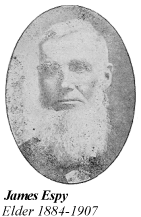 Sabbath School and Bible Classes seem to have been kept up from a
very early period in this church's existence. It is a great loss that
more definite records were not kept, so that credit might be given where
it is due to those who carried on this important phase of church work.
One fact seems clear that up to 1877, the Sabbath school was always
"wound up for the winter" meaning that it was only held for perhaps six
to eight months each year. However, about 1877, when Dr. Alex McKean was
superintendent and ever since that time it has been carried on
continuously. Another of the outstanding superintendents was William
Sutherland who served for twenty-five years, and only ceased when
failing health forbade further service. About 1900 a separate room was
made for the primary class, money for this and its furnishings being
solicited by S. J. Rice.
Sabbath School and Bible Classes seem to have been kept up from a
very early period in this church's existence. It is a great loss that
more definite records were not kept, so that credit might be given where
it is due to those who carried on this important phase of church work.
One fact seems clear that up to 1877, the Sabbath school was always
"wound up for the winter" meaning that it was only held for perhaps six
to eight months each year. However, about 1877, when Dr. Alex McKean was
superintendent and ever since that time it has been carried on
continuously. Another of the outstanding superintendents was William
Sutherland who served for twenty-five years, and only ceased when
failing health forbade further service. About 1900 a separate room was
made for the primary class, money for this and its furnishings being
solicited by S. J. Rice.
The Young People's Society
This
society was started by Rev. J. L. Countermine in 1888. Its aim was that
of a Bible study class requiring' original work by its members rather
than the usual C. E. work. Many character studies were taken up.
Chapters of the Bible were assigned on which the leader asked questions.
Often those who were not church members attended, enjoyed, took part and
were surely benefitted. Some of those who took part in those days were
Anna, George and Lottie Sweesy, Donald, Anna and Helen Sinclair, David
Glenn, Kitty Sutherland, May Moats, Blanche Applegate, Aleck Rice and
his wife, Myrtle Clark, Josephine Sutherland and many others. Though
they are now widely scattered, their influence will always be for good
wherever they may be. There is no record of the time when this society
ceased to be, but it was still in existence in 1911.
The
Missionary Societies
The Women's Missionary society was organized in
1876 in the home of Rev. and Mrs. Rice. It consisted first of young
women, but very soon the mothers, fathers and brothers joined; the men
as honorary members. At one time there were twenty-one honorary members
and thirty-eight women. In the earlier years the meetings were held
twice a month followed by a lunch and social time. During the thirty-six
years of its existence regular meetings were held most of that time.
Funds were divided equally between Home and Foreign missions with an
annual gift to the Freedmen.
The "Send Me" Mission Band
This
mission band was organized by Della Sutherland and Mrs. Rice in 1877 and
had six members. These were Kitty and May Sutherland, Anna and Helen
Sinclair, Nettie Sutherland and Mary Rice. There is no record of when
they were disbanded.
Sunbeam Mission Band
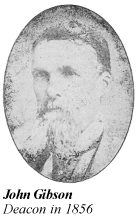 This mission band was organized by Mrs. D. O. Sinclair on January 2,
1898, and has never since closed its work. There were fifteen charter
members, and during this time there have been almost four hundred
members. The membership is composed of the three lower classes in the
Sabbath school, and meetings are held the first Sabbath of each month.
Much interest has always been shown. Members reaching the age of sixteen
or over are honorary members and may do as they like about taking part
or attending the meetings. These children are receiving training which
should help them in later life.
This mission band was organized by Mrs. D. O. Sinclair on January 2,
1898, and has never since closed its work. There were fifteen charter
members, and during this time there have been almost four hundred
members. The membership is composed of the three lower classes in the
Sabbath school, and meetings are held the first Sabbath of each month.
Much interest has always been shown. Members reaching the age of sixteen
or over are honorary members and may do as they like about taking part
or attending the meetings. These children are receiving training which
should help them in later life.
Ladies' Aid Society
The first
record in the church book about this society was in 1923 when they
reported that they had one hundred dollars in their treasury, but the
date of their organization could not be found. They have never ceased
their work for the church since they began and have been much help and
done great good since their beginning. All the women of the church are
members, holding regular monthly meetings and helping wherever possible.
Previous to 1917, when a number of young men left for the World War, a
Young People's Society was carried on for at least two years. Some of
those active in the So-ciety at this time were Ray Sanford, Arthur
Himebaugh, Frank Himebaugh, Ella Loomis, Gladys Himebaugh, Olive Warner,
Miriam Rice, Will Carson, Floyd Sinclair.
The Ministers' Wives
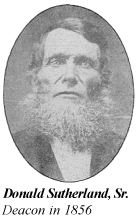 No
history of a church is complete without mention of the wives of our
ministers who have toiled amongst us while their husbands served our
church. Mrs. Kitty Sutherland writes the following lines about them,
giving an insight as to the work of the earlier minister's wives with
whom she had a personal acquaintance:
No
history of a church is complete without mention of the wives of our
ministers who have toiled amongst us while their husbands served our
church. Mrs. Kitty Sutherland writes the following lines about them,
giving an insight as to the work of the earlier minister's wives with
whom she had a personal acquaintance:
"Mrs. Wilson was a stately,
dignified woman, hospitable, and always in sincere sympathy with her
husband in his work for the church.
"Mrs. Rice sang in the choir,
taught a class of young women and later a class of young men in the
Sabbath school; organized the first missionary society in 1875 and with
the assistance of Della Sutherland, organized the first mission band in
1877. Following Mrs. Rice was Mrs. Gay, a bright, cheery English woman
who wore her years so gracefully that one forgot her age. She and her
husband had a code by which she could communicate with him when he was
in the pulpit. A peculiar clearing of her throat let him know that he
had preached long enough. He always heeded her cough and brought his
sermon to a rapid close.
"A childhood playmate of my own, a
girlhood chum and a lifelong friend filled the position of the next
minister's wife—Mrs. Anna Robinson. She had the difficult task of a home
girl in the leadership in the church and she met the requirements fully,
working in the Sabbath school, missionary society and particularly in
the Young People's society which flourished under the care of Mrs.
Robinson and her husband.
"Mrs. Bolton followed Mrs. Robinson.
She too was very active in all kinds of church work. From the bed of
intense suffering from which she was called home she sent this message
to her class of boys in the old church—"Tell my boys to meet me in
Heaven."
"This closed my personal acquittance with the Scotch
Grove ministers' wives. The following women lived and labored amongst
you after I left your community Mrs. Dager who came for only a short
time as a bride; she and her husband going as missionaries to Africa;
Mrs. Hine, Mrs. Offutt, Mrs. Brough, Mrs. Helsing, Mrs. Elges, Mrs.
Park, Mrs. Nash, Mrs. Bond, Mrs. Long and the present minister's wife,
Mrs. Alyea. Each of them, as the years have come and gone, has given her
best. The word failure cannot be written after a single name. Were I an
artist I would take from one of our minister's wives a bit of her
dignity, from another, sincerity, from others the qualities of love,
patience, helpfulness, sympathy, with perhaps a bit of gayety and
beautiful piety. By combining these qualifications into one, I present
'The Mistress of the Manse.' What these women have meant to this church
and community we cannot say until we 'Know as we are known' but we
believe it can be said of each, 'She Hath Done What She Could.' "
The Endowment of the Cemetery
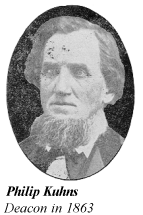 While
the Rev. Wm. H. Elges was serving this church in 1912 to 1916 he
inaugurated a movement in the church and community to endow the
cemetery. He enlisted many to help in this work and $2,500 was raised
and invested. Later this sum was increased to $8,000. The cemetery was
put in good shape and is so maintained by the income from the endowment
which more than serves this purpose.
While
the Rev. Wm. H. Elges was serving this church in 1912 to 1916 he
inaugurated a movement in the church and community to endow the
cemetery. He enlisted many to help in this work and $2,500 was raised
and invested. Later this sum was increased to $8,000. The cemetery was
put in good shape and is so maintained by the income from the endowment
which more than serves this purpose.
The beauty of the cemetery
and the assurance that it will always be so kept by the board of
trustees, is a monument to Mr. Elges and those whose contributions made
this possible.
Our Ministers
Church was organized in June, 1841, by Rev.
Michael Hummer.
Rev. F. A. Pratt, 1849-1850.
Rev. James Galitin,
1851-1866.
Rev. J. L. Wilson, 1856-
Rev. John Rice, 1878-1879.
Rev. J. L. Wilson, 1879-1885.
Rev. Wm. Gay, 1886-1888.
Rev. J. L.
Countermine, 1888.
Rev. W. A. Smith, 1888-1889.
Rev. J. F. Montman,
1889-1890.
Rev. Hugh Robinson 1890-1894, first pastor to be
installed.
Rev. J. M. Bolton, 1894-1898.
Rev. Wm. M. Dager and
other seminary students, 1898-1899.
Rev. Thos. W. Hine, 1899-1901.
Rev. Robt. M. Offutt, 1902-1904.
Rev. John McKay, 1904-1905.
Rev.
R. A. Brough, 1905-1911.
Rev. Oswald Helsing, 1911-1912.
Rev. Wm.
H. Elges, 1912-1916.
Rev. Dennis U. Park, 1917-1919.
Rev. I V.
Nash, 1919-1921.
Rev. J. W. Bond, 1922-1924.
Rev. G. O. Long,
1924-1929.
Alfred Nelson. Student, June to October, 1929.
Rev.
Abram Alyea, 1929-
Elders
Donald Livingston,
June 1841. Dismissed to Wayne in 1861.
Died 1876.
John Sutherland,
June 1841. Died 1877.
David M. Cook, 1866. Dismissed to Hopkinton in
1859.
James Clark, Nov. 3, 1856. Dismissed to Wayne 1861.
Matthew
Dawson, Nov. 3, 1856. Died 1862.
Robert B. McCullough, Nov. 7, 1868.
Dismissed to Creek Indian
Mission 1860.
John Bently, December
1859. Died 1869.
Hugh C. McKean, December 1869. Died 1865.
Samuel
Hazen Clark. June 22, 1862. Died 1890.
Lyman P. Hoyt. June 22, 1862.
Died 1866.
Thomas Lyons. March 25, 1866. Dismissed to Center
Junction.
William Clark. March 25, 1866. Dismissed Westboro, Mo.
1879.
Alexander McKean. Jan. 2, 1877. Dismissed to Onslow 1883.
David Sutherland. March 19, 1871. Died 1903.
James Espy. Jan. 1884.
Died 1907.
C. E. McKean. January 1890. Dismissed to Hopkinton, 1896.
Matthias Sweesy, January 1892. Dismissed to Monticello, 1898.
William
Sutherland, January 1896. Died 1910.
William B. Warner, January 1908.
To Cedar Rapids in 1920.
S. J. Rice, January 7, 1908. Dismissed to De
Ridder, La. in 1920.
R. P. Clark. June 18, 1911. Dismissed to
Monticello, 1928.
Edward C. Hughes, July 1917.
D. O. Sinclair
1928.
H. A. Loomis, 1925. Dismissed to Monticello, 1986.
F. D.
Sutherland, 1928.
W. B. Clark, 1987.
Our Deacons and
Trustees
1856. John Gibson. Moved to Monticello in 1874.
1856. Donald Sutherland, Sr. Resigned in 1877.
1868. Philip Kuhns.
Resigned in 1876.
1871. John Sutherland, Jr. Moved to Scranton in
1878.
1871. Donald Sutherland, Jr. Moved to Clarinda in 1874.
1875. William Sutherland. Elected elder in 1896.
1876. Robert
Sutherland. Dismissed by letter in 1877.
1876. William H. Bolton.
Dismissed by letter in 1881.
1878. Angus Sinclair. Died 1901.
1879. William Sutherland. Died in 1879.
1881. Mathias Sweesy. Elected
elder in 1892. To Monticello.
1883. C. B. McKean. Elected elder 1890.
To Hopkinton.
1888. S. J. Rire. Elected elder in 1908. Dismissed,
Louisiana, 1921.
1892. D. E. Glenn. Removed to California.
1896.
D. O. Sinclair. Elected elder in 1928.
1904. G. J. Hughes
1913. H.
H. Carson.
1924. J. W. Calahan. Died in 1931.
1932. M. M.
Sinclair.
On March 10, 1931, article three of the incorporation of
the church was voted to read "trustee" instead of "deacon."
CENTENNIAL PROGRAM
Held at Scotch Grove,
Iowa, on
August 14 and 15, 1937.
SATURDAY, AUGUST 14
10:00 a.m.—Band Concert.
Horseshoe Pitching Contest.
10:30
a.m.—Dedication of Marker at H. H. Carson Farm.
Commemorating Turning of First Sod in Scotch Grove Township.
Speaker—Professor Swisher of Iowa City, and others.
12:00
Noon—Chicken Dinner.
1:00 p.m.—Parade of Floats.
2:00 p.m.—Band
Concert.
2:30 p.m.—Program—
Music.
Address—Prof.
Holbrook of Ames, Iowa
Shork Talks—Former Residents
Music.
3:30 p.m.—Kitttenball Game. Contests and Races.
Liberal Purses will be offered.
7:30 p.m.—Band Concert.
8:00 p.m.—Historical Pageant.
9:00 p.m.—Dance—Old Time and Popular
Music
Skersick Orchestra.
10:00
p.m.—Drawing—Prize Cake.
SUNDAY, AUGUST 15
Scotch
Grove Presbyterian Church
10:00 a.m.—Devotional Service.
Service and Communion.
Music by the Center Junction Choir.
11:30
a.m.—Free Dinner.
Served by the Ladies Aid.
1:30
p.m.—Congregational Singing.
Historical Sermon.
Reading of Letters
from Absent Friends.
7:30 p.m.—Evening Service.
Sacred Concert by
the Young People.
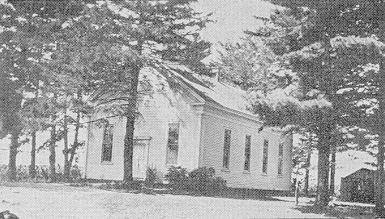
PRESENT PRESBYTERIAN CHURCH AT SCOTCH GROVE.
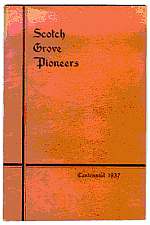 Compiled
at the time of the Centennial Celebration of Scotch Grove, August 14
and 15, 1937
Compiled
at the time of the Centennial Celebration of Scotch Grove, August 14
and 15, 1937 



 There
was no fanfare of trumpets, not even the skirling of the bagpipes,
perhaps only a simple Gaelic prayer of thanksgiving to mark the
beginning of this new era in the lives of these people. Yet this event
was history in the making; for this handful of Scotch men and women were
to share in the development of a great agricultural area. They were to
do their part for church and school, for government and country.
There
was no fanfare of trumpets, not even the skirling of the bagpipes,
perhaps only a simple Gaelic prayer of thanksgiving to mark the
beginning of this new era in the lives of these people. Yet this event
was history in the making; for this handful of Scotch men and women were
to share in the development of a great agricultural area. They were to
do their part for church and school, for government and country. Deeply
religious, their church was doubly dear to them, since the men of
Kildonan for countless generations had worshipped on the same spot.
Kildonan, meaning the cell of Saint Donnan, had been established
there by Saint Donnan 617 A.D., and the church itself had been built
and rebuilt by the hands of Highland men. Situated on the banks of
the Helmsdale river (a corrupt form of the Gaelic for Ullidh's dale)
the kirk was the heart of the parish. Many of the shielings were
clustered about it, and these humble folk loved that churchyard
where their dead lay. Even today the worn and battered communion cup
they drank from, now kept in a place of honor in the parish, is an
eloquent testimony to their faith and devotion.
Deeply
religious, their church was doubly dear to them, since the men of
Kildonan for countless generations had worshipped on the same spot.
Kildonan, meaning the cell of Saint Donnan, had been established
there by Saint Donnan 617 A.D., and the church itself had been built
and rebuilt by the hands of Highland men. Situated on the banks of
the Helmsdale river (a corrupt form of the Gaelic for Ullidh's dale)
the kirk was the heart of the parish. Many of the shielings were
clustered about it, and these humble folk loved that churchyard
where their dead lay. Even today the worn and battered communion cup
they drank from, now kept in a place of honor in the parish, is an
eloquent testimony to their faith and devotion. In 1808, Lord Selkirk having secured the control of the Hudson's Bay
Company had acquired from that organization approximately 110,000 square
miles of land, from the grand forks of the Red River and the Assiniboia
to the headwaters of Lake Winnipeg. This land was largely unbroken
prairie and included some of the best wheat land on the continent. While
the Earl undoubtedly launched his plan in the interests of the
impoverished and evicted Scottish farmers, he also had an eye to the
interests of the Company by providing cheap labor in the trading posts
and a ready supply of cheaper provisions in the country.
In 1808, Lord Selkirk having secured the control of the Hudson's Bay
Company had acquired from that organization approximately 110,000 square
miles of land, from the grand forks of the Red River and the Assiniboia
to the headwaters of Lake Winnipeg. This land was largely unbroken
prairie and included some of the best wheat land on the continent. While
the Earl undoubtedly launched his plan in the interests of the
impoverished and evicted Scottish farmers, he also had an eye to the
interests of the Company by providing cheap labor in the trading posts
and a ready supply of cheaper provisions in the country. According to Dr. George Bryce, an authority on the history
of the period, the ships lists found in the archives at Ottawa and
Montreal are far from complete or correct. Of this group of seventy-one
only seventeen names are given, including that of a John McIntyre.
However, the Honor Roll in Martin's Hudson's Bay Company Tenures
indicates those who arrived each year, and this includes among the
arrivals of 1812 the names of Donald Livingston, Alexander Mclean, John
McLean, Alexander McBeath, and John Sutherland, all names significant in
Scotch Grove history.
According to Dr. George Bryce, an authority on the history
of the period, the ships lists found in the archives at Ottawa and
Montreal are far from complete or correct. Of this group of seventy-one
only seventeen names are given, including that of a John McIntyre.
However, the Honor Roll in Martin's Hudson's Bay Company Tenures
indicates those who arrived each year, and this includes among the
arrivals of 1812 the names of Donald Livingston, Alexander Mclean, John
McLean, Alexander McBeath, and John Sutherland, all names significant in
Scotch Grove history. At Stromness the people were lodged in the homes of the inhabitants
until ready to embark. They had expected Lord Selkirk to meet them here
and to accompany them to Assiniboia but were disappointed to learn that
the affairs of the colony were such that the Earl would have to wait
until a later boat.
At Stromness the people were lodged in the homes of the inhabitants
until ready to embark. They had expected Lord Selkirk to meet them here
and to accompany them to Assiniboia but were disappointed to learn that
the affairs of the colony were such that the Earl would have to wait
until a later boat. Since the colonists could not winter on the barren rocks of Sloop's Cove
nor elsewhere in that exposed area, it was decided to make a camp
fifteen miles from the fort on the wooded banks of the Churchill river.
In deep snow, with unfinished huts and scanty clothing the settlers
suffered terribly. Food was scarce and the nearest supplies were fifteen
miles away. The manual labor under such adverse circumstances was very
hard for them, but their leader said of them, "The settlers proved
willing though possessed of an indomitable Presbyterian aversion to work
on Sunday."
Since the colonists could not winter on the barren rocks of Sloop's Cove
nor elsewhere in that exposed area, it was decided to make a camp
fifteen miles from the fort on the wooded banks of the Churchill river.
In deep snow, with unfinished huts and scanty clothing the settlers
suffered terribly. Food was scarce and the nearest supplies were fifteen
miles away. The manual labor under such adverse circumstances was very
hard for them, but their leader said of them, "The settlers proved
willing though possessed of an indomitable Presbyterian aversion to work
on Sunday." A
fourth party landed at York Factory, August 26, 1815, and proceeded to
the Forks, or Kildonan as it was affectionately called for the parish
that had been home to generations of these immigrants. This group was
especially important because it brought James Sutherland, an elder
called a Catechist and authorized to marry and baptize. Until his
removal to Eastern Canada he took the place of the Presbyterian minister
Lord Selkirk had promised these people—a promise he did not fulfil.
Others listed in this party are William Sutherland, 54; Isabel
Sutherland 50, his wife; Jeremiah 15, Ebenezer 11, Donald 7, Helen 12,
his children. The last three are mentioned as being at school. The three
eldest children of this family, Alexander, William and Kate or Catherine
had come with the third party, William dying at sea.
A
fourth party landed at York Factory, August 26, 1815, and proceeded to
the Forks, or Kildonan as it was affectionately called for the parish
that had been home to generations of these immigrants. This group was
especially important because it brought James Sutherland, an elder
called a Catechist and authorized to marry and baptize. Until his
removal to Eastern Canada he took the place of the Presbyterian minister
Lord Selkirk had promised these people—a promise he did not fulfil.
Others listed in this party are William Sutherland, 54; Isabel
Sutherland 50, his wife; Jeremiah 15, Ebenezer 11, Donald 7, Helen 12,
his children. The last three are mentioned as being at school. The three
eldest children of this family, Alexander, William and Kate or Catherine
had come with the third party, William dying at sea. Alexander
Ross, a one time sheriff of Red River and a member of the first council,
in his book, "The Red River Settlement." published in London in 1856,
relates the successes and trials of the growing colony.
Alexander
Ross, a one time sheriff of Red River and a member of the first council,
in his book, "The Red River Settlement." published in London in 1856,
relates the successes and trials of the growing colony. That life in Red River was not all struggle and hardship, mixed with
Gaelic prayers, as the descendants of these pioneers were sometimes led
to think, is evident from the letter written by Thomas Simpson at Fort
Garry to Donald Ross at Norway House in 1834.
That life in Red River was not all struggle and hardship, mixed with
Gaelic prayers, as the descendants of these pioneers were sometimes led
to think, is evident from the letter written by Thomas Simpson at Fort
Garry to Donald Ross at Norway House in 1834. The
immediate spiritual needs of these Presbyterians was supplied by James
Sutherland the catechist, until his removal to Eastern Canada. All the
requests for a minister of their own were ignored by Lord Selkirk and
later by his agents, and not until 1852 did the Red River Settlement
have a Presbyterian minister. Then the Rev. John Black came, and the
Kildonan church was built along the same lines of architecture as the
mother church in Sutherlandshire. The Scotch Grove church building also
shows the influence of this mother church.
The
immediate spiritual needs of these Presbyterians was supplied by James
Sutherland the catechist, until his removal to Eastern Canada. All the
requests for a minister of their own were ignored by Lord Selkirk and
later by his agents, and not until 1852 did the Red River Settlement
have a Presbyterian minister. Then the Rev. John Black came, and the
Kildonan church was built along the same lines of architecture as the
mother church in Sutherlandshire. The Scotch Grove church building also
shows the influence of this mother church. Other
families in the party were whose of Alexander McLean, David McCoy,
(originally spelled McKay). These people seem to have settled farther
west and north than the others. The McCoy spring has always been one of
the landmarks of the township. The fifth member of the party was Joseph
Bremmer. He evidently was a widower, for he and his son called "Willie",
a cripple, lived alone many years. The McCoys and the Bremmers are not
named in the ship's list of the first parties, so they had evidently
joined the Selkirk settlers at a later date, as did the Donald Sinclairs
and other families who later came to Scotch Grove.
Other
families in the party were whose of Alexander McLean, David McCoy,
(originally spelled McKay). These people seem to have settled farther
west and north than the others. The McCoy spring has always been one of
the landmarks of the township. The fifth member of the party was Joseph
Bremmer. He evidently was a widower, for he and his son called "Willie",
a cripple, lived alone many years. The McCoys and the Bremmers are not
named in the ship's list of the first parties, so they had evidently
joined the Selkirk settlers at a later date, as did the Donald Sinclairs
and other families who later came to Scotch Grove.
 From
1845 on German, Irish, and Yankee settlers came to the locality and much
of the progress of the settlement is due these people as well as those
who came before them. After settlement for the first few years the only
mill where corn and wheat could be ground was on Catfish Creek, near
Dubuque. In 1847 a sawmill was built at Dale's ford, but it was entirely
washed away in 1865 and never rebuilt. In 1858 Charles Applegate* built
a gristmill and later a sawmill, which has since been operated by Samuel
Eby, his son Joseph, and William Lange. The mill itself has been torn
down and the property belongs now to John W. Hutton. In 1860, J. P.
Tibbits had a small sawmill five miles above Dale's ford, but this was
washed away in 1876. All that remains at the place is Mr. Tibbit's grave
on a nearby, high bluff. One other small mill was operated on Mineral
creek but only a short time.
From
1845 on German, Irish, and Yankee settlers came to the locality and much
of the progress of the settlement is due these people as well as those
who came before them. After settlement for the first few years the only
mill where corn and wheat could be ground was on Catfish Creek, near
Dubuque. In 1847 a sawmill was built at Dale's ford, but it was entirely
washed away in 1865 and never rebuilt. In 1858 Charles Applegate* built
a gristmill and later a sawmill, which has since been operated by Samuel
Eby, his son Joseph, and William Lange. The mill itself has been torn
down and the property belongs now to John W. Hutton. In 1860, J. P.
Tibbits had a small sawmill five miles above Dale's ford, but this was
washed away in 1876. All that remains at the place is Mr. Tibbit's grave
on a nearby, high bluff. One other small mill was operated on Mineral
creek but only a short time.

 From
Mrs. Lottie Sweesy Johnston, a granddaughter of the giver of the
land we learn "that during the short time for which Rev. James
Galitan was their minister, the membership built the first house
of worship in the summer of 1851. This church, a small frame
building, was erected in the cemetery a short distance northeast
of where the soldiers' monument now stands. N. W. Austin and his
helpers, Mr. Stewart and Mr. McFadden, were given the building
contract. The stone was furnished by Ebenezer Sutherland from
the quarry on his farm. Most of the frame timber was obtained
from the Rev. F. Amos' saw mill above Dale Mill bridge on the
Maquoketa River. Since the mill could not supply oak timbers
sufficiently long for the cross beams to support the ceiling,
these were taken from the timber. Ebenezer Sutherland, his son
D. W. Sutherland and William A. Sutherland went out into the
woods and wherever they found a tall, straight oak tree they cut
it no matter on whose land it was. When they raised the frame,
all the neighborhood gathered to help, and were served a picnic
dinner by the women.
From
Mrs. Lottie Sweesy Johnston, a granddaughter of the giver of the
land we learn "that during the short time for which Rev. James
Galitan was their minister, the membership built the first house
of worship in the summer of 1851. This church, a small frame
building, was erected in the cemetery a short distance northeast
of where the soldiers' monument now stands. N. W. Austin and his
helpers, Mr. Stewart and Mr. McFadden, were given the building
contract. The stone was furnished by Ebenezer Sutherland from
the quarry on his farm. Most of the frame timber was obtained
from the Rev. F. Amos' saw mill above Dale Mill bridge on the
Maquoketa River. Since the mill could not supply oak timbers
sufficiently long for the cross beams to support the ceiling,
these were taken from the timber. Ebenezer Sutherland, his son
D. W. Sutherland and William A. Sutherland went out into the
woods and wherever they found a tall, straight oak tree they cut
it no matter on whose land it was. When they raised the frame,
all the neighborhood gathered to help, and were served a picnic
dinner by the women. Robert
Sutherland Rummell a great, great grandson of one of these pioneer men,
tells us as follows about the church bell:
Robert
Sutherland Rummell a great, great grandson of one of these pioneer men,
tells us as follows about the church bell: Music in the church was always a part of the service, and more people
sang then than do now. Hymn books were very few and the hymns were
"lined out" so that all might use the words. The tune was "pitched" by
someone who used a tuning fork, a small metal fork about the length of a
lead pencil, which when struck on a hard surface, produced an "A" tone
from which the leader took his pitch.
Music in the church was always a part of the service, and more people
sang then than do now. Hymn books were very few and the hymns were
"lined out" so that all might use the words. The tune was "pitched" by
someone who used a tuning fork, a small metal fork about the length of a
lead pencil, which when struck on a hard surface, produced an "A" tone
from which the leader took his pitch. Sabbath School and Bible Classes seem to have been kept up from a
very early period in this church's existence. It is a great loss that
more definite records were not kept, so that credit might be given where
it is due to those who carried on this important phase of church work.
One fact seems clear that up to 1877, the Sabbath school was always
"wound up for the winter" meaning that it was only held for perhaps six
to eight months each year. However, about 1877, when Dr. Alex McKean was
superintendent and ever since that time it has been carried on
continuously. Another of the outstanding superintendents was William
Sutherland who served for twenty-five years, and only ceased when
failing health forbade further service. About 1900 a separate room was
made for the primary class, money for this and its furnishings being
solicited by S. J. Rice.
Sabbath School and Bible Classes seem to have been kept up from a
very early period in this church's existence. It is a great loss that
more definite records were not kept, so that credit might be given where
it is due to those who carried on this important phase of church work.
One fact seems clear that up to 1877, the Sabbath school was always
"wound up for the winter" meaning that it was only held for perhaps six
to eight months each year. However, about 1877, when Dr. Alex McKean was
superintendent and ever since that time it has been carried on
continuously. Another of the outstanding superintendents was William
Sutherland who served for twenty-five years, and only ceased when
failing health forbade further service. About 1900 a separate room was
made for the primary class, money for this and its furnishings being
solicited by S. J. Rice. This mission band was organized by Mrs. D. O. Sinclair on January 2,
1898, and has never since closed its work. There were fifteen charter
members, and during this time there have been almost four hundred
members. The membership is composed of the three lower classes in the
Sabbath school, and meetings are held the first Sabbath of each month.
Much interest has always been shown. Members reaching the age of sixteen
or over are honorary members and may do as they like about taking part
or attending the meetings. These children are receiving training which
should help them in later life.
This mission band was organized by Mrs. D. O. Sinclair on January 2,
1898, and has never since closed its work. There were fifteen charter
members, and during this time there have been almost four hundred
members. The membership is composed of the three lower classes in the
Sabbath school, and meetings are held the first Sabbath of each month.
Much interest has always been shown. Members reaching the age of sixteen
or over are honorary members and may do as they like about taking part
or attending the meetings. These children are receiving training which
should help them in later life. No
history of a church is complete without mention of the wives of our
ministers who have toiled amongst us while their husbands served our
church. Mrs. Kitty Sutherland writes the following lines about them,
giving an insight as to the work of the earlier minister's wives with
whom she had a personal acquaintance:
No
history of a church is complete without mention of the wives of our
ministers who have toiled amongst us while their husbands served our
church. Mrs. Kitty Sutherland writes the following lines about them,
giving an insight as to the work of the earlier minister's wives with
whom she had a personal acquaintance: While
the Rev. Wm. H. Elges was serving this church in 1912 to 1916 he
inaugurated a movement in the church and community to endow the
cemetery. He enlisted many to help in this work and $2,500 was raised
and invested. Later this sum was increased to $8,000. The cemetery was
put in good shape and is so maintained by the income from the endowment
which more than serves this purpose.
While
the Rev. Wm. H. Elges was serving this church in 1912 to 1916 he
inaugurated a movement in the church and community to endow the
cemetery. He enlisted many to help in this work and $2,500 was raised
and invested. Later this sum was increased to $8,000. The cemetery was
put in good shape and is so maintained by the income from the endowment
which more than serves this purpose.